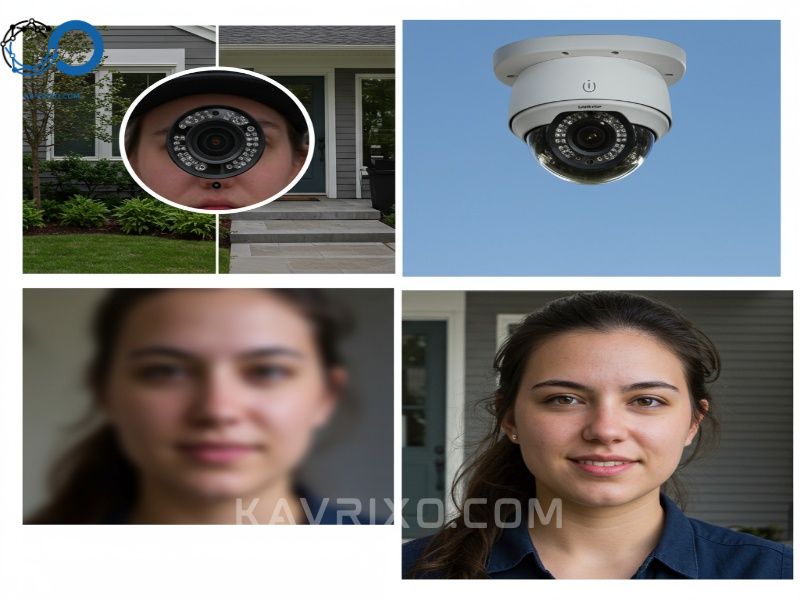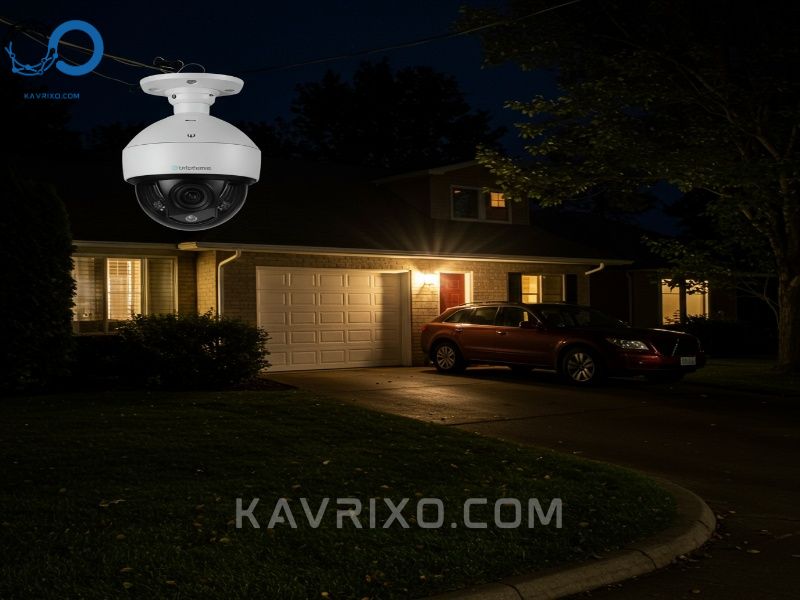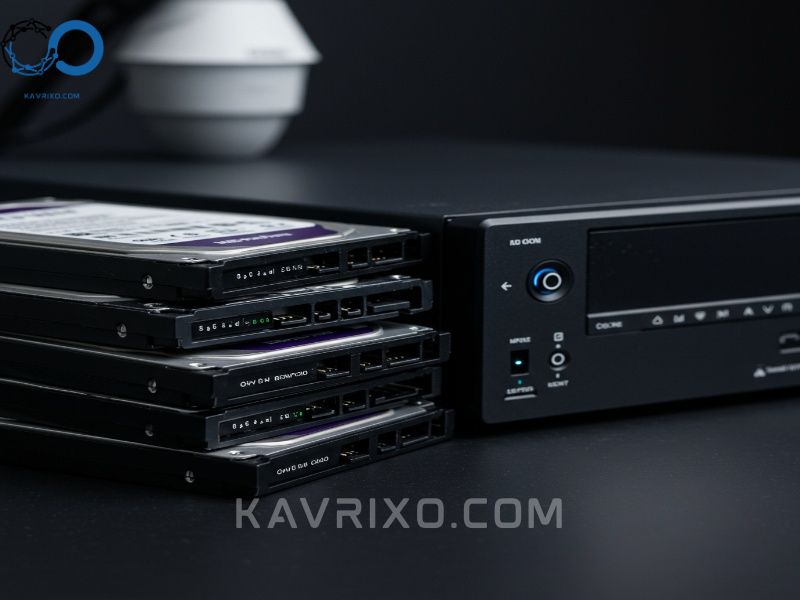In the complex and rapidly evolving world of security, the clarity of the image is not merely a luxury—it is the critical difference between observing an event and successfully identifying the perpetrator or capturing crucial evidence. For years, 1080p (2-megapixel) and even 720p systems were considered adequate, offering a decent view of activities. However, those standards are quickly becoming obsolete in the face of modern security threats and technological advancements. Today, the 4k security camera has emphatically taken the throne as the definitive standard for both residential and commercial protection, offering a level of detail that was previously confined to high-end cinema.
A 4k resolution security camera delivers images that contain approximately 8 million pixels (3840 x 2160), four times the resolution of a standard 1080p camera. This exponential leap in fidelity fundamentally transforms how we approach surveillance. It means the difference between seeing a blurry figure leaving your property and capturing a crystal-clear image of a face, a license plate number, or specific details about clothing or tools. When the stakes are high, choosing a high resolution security camera is the only logical decision.
This comprehensive guide will delve into the technical superiority of 4K, explore the various system options available (from wired PoE setups to the convenient 4k wireless security camera), and provide practical advice on building the ultimate 4k surveillance camera system designed for maximum effectiveness and peace of mind.
Contents
- 1 The Definitive Advantage of 4K Resolution in Security
- 2 Navigating the 4K Security Camera Landscape: Types and Technologies
- 3 Beyond Daylight: Achieving Clarity with the Best 4K Color Night Vision Security Camera
- 4 Building Your 4K Surveillance Camera System: Components and Considerations
- 5 The Commercial Edge: Deploying High Definition Security Cameras in Business Settings
- 6 Making the Investment: Why a 4K Security Camera System Offers Unmatched ROI
- 7 Conclusion: The Era of Blurry Security Footage is Over
The Definitive Advantage of 4K Resolution in Security
The move from High Definition (HD) to Ultra High Definition (UHD or 4K) represents more than just a marketing buzzword; it’s a technological breakthrough that directly impacts the utility of your video surveillance. When evaluating any security investment, the primary question is, “Will this footage be useful?” With 4K, the answer is an undeniable “yes.”
Pixel Density and Detail Capture: 4K vs. Traditional HD Security Camera Systems
The core benefit of a 4k security camera lies in its pixel density. While a traditional 1080p camera captures roughly 2 megapixels, a true 4k cctv camera captures 8.3 megapixels. This massive increase in data translates directly into visual information:
- Forensic Detail: In a 1080p image, if a perpetrator is 50 feet away, their face might occupy only a handful of pixels, rendering identification impossible. In contrast, the sheer density of a 4k resolution security camera ensures that even small objects or distant features—like tattoos, logos, or identifying scars—remain distinct and recognizable, even when zoomed in after the fact.
- Wide Field of View (FoV) Without Distortion: Because 4K captures so much data, you can cover a much larger area with a single camera without sacrificing the necessary detail for identification. This is particularly valuable for monitoring large spaces like parking lots, warehouses, or expansive backyards. Instead of needing four separate 1080p cameras, often one or two 4k outdoor security camera units can achieve superior coverage, simplifying installation and reducing hardware costs.
The image quality provided by a modern hi res security camera ensures that the video surveillance footage is admissible and powerful evidence, offering the necessary clarity that older, low-resolution systems simply cannot deliver.

Enhanced Digital Zoom Capabilities
Perhaps the most practical benefit of a high-resolution sensor is the power of digital zoom. Standard security cameras often feature optical zoom, which is excellent but limits flexibility. Digital zoom, however, relies entirely on the underlying pixel count.
When you digitally zoom on a 1080p image, you quickly reach a point where the pixels become large, blocky, and useless (pixelation). Since a 4k camera system starts with four times the pixels, you have a vast reserve of visual data to draw upon. This means you can zoom in 2x, 3x, or even 4x on a specific area of interest (e.g., a person standing by a door, or a specific shelf in a retail environment) and still retain the equivalent of 1080p or even 720p usable resolution.
This enhanced zoom capability fundamentally changes post-incident analysis, turning generic footage into actionable evidence. For critical areas, choosing a 4k ip camera with both optical and digital zoom capabilities offers the ultimate flexibility in capturing close-up detail across a wide field.
When choosing a 4k surveillance camera system, buyers are often faced with a variety of choices concerning connectivity, power delivery, and specialized features. Understanding these options is key to building a robust and reliable setup tailored to specific security needs.
Wired 4K IP Camera Systems (PoE)
For those prioritizing reliability, consistent performance, and ease of power management, a Power over Ethernet (PoE) 4k camera system for home or business remains the gold standard.
PoE systems use a single Ethernet cable (Cat5e or Cat6) to transmit both electrical power and video data. This simplifies installation, as there is no need for separate power outlets near each camera. Modern 4k ip camera units excel in this environment because Ethernet provides the necessary stable bandwidth to handle the massive data streams generated by continuous 4K recording.
Key Advantages of Wired PoE:
- Maximum Reliability: No interference or signal loss issues common with wireless connections.
- High Bandwidth: Easily handles the high frame rates required for smooth video surveillance 4k.
- Centralized Power: Managed via the Network Video Recorder (NVR) or a PoE switch.
The Rise of the 4K Wireless Security Camera
While wired systems offer unmatched stability, the convenience and flexibility of a 4k wireless security camera cannot be overstated, especially for renters or properties where running cables is impractical.
Modern 4k wireless camera systems utilize advanced compression codecs (like H.265+) and often operate on dual-band Wi-Fi (2.4 GHz and 5 GHz) to manage the substantial data demands of high resolution video surveillance camera footage.
It is crucial to understand that even in a “wireless” system, the camera typically still needs to be plugged into a power source (unless it is a battery-powered unit, which may sacrifice continuous recording capability for energy conservation). The “wireless” aspect refers only to the transmission of data back to the recorder or cloud storage. When selecting a 4k wireless camera, ensure your home network infrastructure is robust enough to handle the constant, high-volume data traffic.

Essential Features: WDR, HDR, and Smart Analytics
The resolution is only one part of the equation. To maximize the utility of your 4k surveillance camera, look for crucial image processing and smart features:
- Wide Dynamic Range (WDR) / High Dynamic Range (HDR): These technologies are vital for handling challenging lighting conditions, such as scenes where a strong backlight (like a sunrise or car headlights) could cause foreground objects to appear as dark silhouettes. WDR ensures that both the bright and shadowed areas of the image are properly exposed, preserving detail.
- Smart Analytics (AI): The massive amount of data captured by a 4k surveillance camera is perfect for advanced Artificial Intelligence (AI) features. These systems can differentiate between a person, a vehicle, and a pet, drastically reducing false alerts. The high fidelity allows AI systems to perform actions like accurate perimeter breach detection and loitering analysis with greater confidence than lower resolution cameras.
Beyond Daylight: Achieving Clarity with the Best 4K Color Night Vision Security Camera
One of the greatest limitations of older security systems was their complete failure in low-light conditions. Traditional infrared (IR) night vision provides a black-and-white image, which is sufficient for motion detection but completely inadequate for forensic identification (since color, clothing description, and environmental context are lost).
The modern solution is the best 4k color night vision security camera, which has revolutionized nighttime surveillance.
Starlight Sensors and Low-Light Performance
The ability of a camera to see clearly in near-total darkness without relying solely on blinding IR LEDs is achieved through specialized sensors, often referred to as “Starlight” sensors.
Starlight technology uses large aperture lenses and highly sensitive image sensors that can capture and amplify trace amounts of ambient light (from streetlights, the moon, or distant windows). When paired with the high pixel count of a 4k cctv camera, the result is a full-color, high-detail image even in extremely dark conditions.
This feature is arguably one of the most significant upgrades provided by modern high definition security cameras. Capturing the color of a vehicle or the jacket worn by an intruder at 3:00 AM is essential information that traditional IR systems simply cannot provide.

Active Deterrence and Integrated Lighting
Many premium 4k outdoor camera units now integrate active deterrence features, which work hand-in-hand with high-resolution recording.
Active deterrence often involves motion-activated spotlights (sometimes called floodlights or supplemental white light) and two-way audio sirens. When motion is detected, the spotlight immediately illuminates the area. This serves two key functions:
- Deterrence: The sudden light and sound often scare away potential intruders.
- Image Quality: The white light ensures that the camera captures the event in perfect, full-color daylight quality, providing the best 4k security camera footage possible for any investigation.
Building Your 4K Surveillance Camera System: Components and Considerations
Implementing a best 4k surveillance camera system requires careful planning, especially regarding data management and infrastructure, as 4K video consumes considerably more bandwidth and storage than older formats.
NVR vs. DVR: Choosing the Right Recorder for High Resolution Video Surveillance
The recorder is the brain of your system. You will primarily encounter two types:
- Digital Video Recorder (DVR): Used exclusively for older analog or HD over Coax (HDCVI, HD-TVI) systems. DVRs typically cannot handle the native resolution of a modern 4k ip camera and require specialized cabling. While some hybrid DVRs exist, they are generally not recommended for true 4K performance.
- Network Video Recorder (NVR): Essential for an IP-based 4k camera system. NVRs process digital video streams directly from the cameras over the network. They are designed to handle the high throughput and processing power required to manage multiple high resolution video surveillance camera feeds simultaneously. If you are investing in 4K, an NVR is mandatory.
When selecting an NVR for a best 4k cctv system, ensure it has sufficient encoding power to record at 4K resolution and a high enough channel count for future expansion.
Bandwidth and Storage Demands of 4K CCTV Camera Footage
The primary challenge of adopting 4K is data management. A continuous 4K stream can easily require 10-20 Mbps (megabits per second) of bandwidth per camera. If you run a system with eight 4k outdoor security camera units, you are looking at substantial network traffic and immense storage needs.
To mitigate this, modern 4K systems rely on two key technologies:
- H.265 Compression: This advanced video compression standard is crucial. H.265 (or HEVC) can reduce the file size of high-resolution video by up to 50% compared to the older H.264 standard, without significantly compromising image quality. Ensure your cameras and NVR both support this codec.
- Purpose-Built Hard Drives (HDDs): Standard desktop hard drives are not built for the 24/7 read/write cycles of constant security recording. You must use surveillance-grade hard drives (like Western Digital Purple or Seagate Skyhawk), which are optimized for continuous operation and handling the massive concurrent data streams generated by a 4k cctv camera system. Plan for significant storage capacity—a small system might require 4TB to 8TB for just a few weeks of recording.

Installation and Positioning of 4K Outdoor Security Camera Units
Proper installation maximizes the effectiveness of your 4k outdoor security camera. Because 4K captures so much detail, careful positioning can eliminate the need for extra cameras:
- Identify Choke Points: Position cameras to clearly view entry points, gates, and delivery areas. Since the resolution is so high, ensure the camera is close enough to capture identifying characteristics (the “DORI distance”—Detection, Observation, Recognition, Identification).
- Minimize Backlight: If possible, avoid pointing the camera directly into the sun or toward highly reflective surfaces, even with WDR technology.
- Height and Angle: For facial recognition and identification, cameras should be mounted high enough to prevent easy tampering but angled down sufficiently to capture faces rather than just the tops of heads. A slightly lower mounting height (8-10 feet) is often better for capturing identifying details at residential properties.
The Commercial Edge: Deploying High Definition Security Cameras in Business Settings
While homeowners benefit greatly from the detail of a 4k camera system for home, businesses find that 4K resolution is often a necessity rather than an option. Commercial environments demand proof, accountability, and the ability to monitor complex operations.
License Plate and Facial Recognition Accuracy
In commercial applications, especially those requiring perimeter control, logistics management, or monitoring high-traffic areas, the ability to read small details is paramount.
An hd cctv camera operating at 1080p struggles significantly with License Plate Recognition (LPR) unless the camera is specifically designed and placed very close to the vehicle path. A 4k surveillance camera, however, provides the necessary density to capture clear license plates even when vehicles are moving at moderate speeds or are positioned further away from the lens.
Similarly, in retail or access control scenarios, the enhanced clarity of a high def security camera system drastically improves the performance of AI-powered facial recognition software, ensuring accurate tracking of employees, customers, or restricted personnel. This forensic accuracy makes the best 4k cctv camera an essential tool for loss prevention.

Scaling a Best 4K CCTV System for Large Properties
For large commercial or institutional properties (campuses, hospitals, large manufacturing plants), scaling up a system is a major concern. Using a best 4k security camera system actually makes scaling more efficient.
Since a single 4K camera can effectively replace multiple 1080p cameras due to its superior coverage and zoom capabilities, the overall installation footprint and cabling complexity are reduced. While the initial cost per 4K unit might be higher, the reduction in labor, wiring, and the number of required NVR ports often results in a better long-term total cost of ownership (TCO). Furthermore, managing fewer, higher-quality feeds is usually simpler for security teams than trying to manage dozens of lower-resolution streams.
Making the Investment: Why a 4K Security Camera System Offers Unmatched ROI
The decision to invest in a 4k security camera system ultimately boils down to Return on Investment (ROI). While the initial hardware cost may be higher than budget 1080p alternatives, the enhanced capabilities provide immediate and long-term value that far outweighs the difference.
Future-Proofing Your Security Infrastructure
Technology cycles are accelerating. Investing in a 4K system today means you are installing equipment that meets and exceeds current industry standards. While 8K technology is on the horizon, 4K is firmly established as the practical, high-performance sweet spot, offering the perfect balance between image quality and manageable data consumption. Choosing a high def security cameras system now ensures your surveillance infrastructure remains effective for years to come.
Peace of Mind and Actionable Intelligence
The true value of a best 4k security camera is realized the moment an incident occurs. Knowing that your system captured the absolute highest level of detail available provides invaluable peace of mind. Whether dealing with insurance claims, law enforcement investigations, or internal disputes, the undeniable clarity of 4K footage is your most potent tool. It shifts the footage from being mere background video to becoming actionable intelligence.
If security is a priority—and for any property owner, it should be—upgrading to a modern, high-performance 4k surveillance camera system is the most crucial step you can take toward comprehensive protection.

Conclusion: The Era of Blurry Security Footage is Over
The technology exists today to eliminate the frustration of blurry, unusable security footage. The 4k security camera is not merely an incremental upgrade; it is a fundamental shift in surveillance capability. By offering four times the resolution of previous standards, enhanced digital zoom, superior nighttime performance through color night vision, and better integration with smart AI analytics, 4K systems deliver forensic detail necessary for identification and evidence.
Whether you are seeking the convenience of a 4k wireless camera system for a residential property or the robust reliability of a PoE 4k cctv camera system for a large enterprise, the investment in video surveillance 4k resolution guarantees that when you need the details most, they will be there, crystal clear. Don’t settle for “good enough” resolution; choose the clarity and confidence that only 4K can provide.
